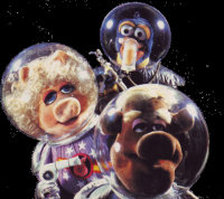 With a growl I rise from hibernation to attempt a public service. I'm a sucker for fantasy and science fiction movies. City-stomping lizards. Warp drive. Wookies. Astonishingly big smurfs. Dream control. Turning back time by flying really fast. I grin when a fellow techie saves the day, whether it’s The Professor or Mr. Spock. Release a fundamental restriction or two, and fantasy and science fiction can experiment with big questions. What does it mean to be human? What is time? Could you survive a mob of zombies with only your wits and a piece of string? The big questions! I’m game for inconsistencies for a worthwhile cause. I enjoy a diversion. As a guy named Tolkien urged, “Fantasy is escapist, and that is its glory. If a soldier is imprisoned by the enemy, don't we consider it his duty to escape?  One of the satellites in Gravity One of the satellites in Gravity that you can see for yourself From its trailers I expected the movie Gravity to be a survival epic, sort of Apollo 13 meets Speed. Indeed, the opening minutes of Gravity had little to upset my willing suspension of disbelief. Borrowing a space shuttle from a museum, Sandra Bullock's character (an MD?) fixes the Hubble Space Telescope. If you have a clear southern sky, low on the horizon you can spot the Hubble Space Telescope around sunset or sunrise. It follows the equator, moving from our point of view southwest to southeast, returning every 96 minutes. The earth is 24,000 miles around. To circle the earth in an hour and a half, the Hubble Space Telescope speeds along at around 17,000 miles per hour. I was engrossed in this unfolding action, but then the George Clooney cowboy warns that a lethal cloud of satellite debris would orbit back in 93 minutes! That remark rudely smacked me out of orbit. 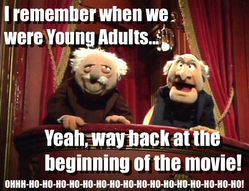 Drop a paper clip and a cannon ball from the same height. Equal-opportunity gravity makes them hit the earth at the time. Two objects in the same circular orbit take the same time to “fall around the earth” and return to where they started. Since the debris swarm moves relatively faster, it must be in a different orbit. Clooney is needlessly alarmed. Well, except for running out of air. Unless... Wait, what's this? Our intrepid astronauts are orbiting east to west? I grew up during the 1960’s space race. Just by looking up, I saw that satellites travel basically from west to east, so at launch the rotation of the earth gives ‘em an extra push. So maybe--with the help of two lift rockets--the satellite debris and the astronauts are in the same orbit but going opposite directions. No wonder our astronauts have trouble with oncoming traffic! In space no one can hear you honk. Still, shouldn't they meet the dangerous debris not once but twice per orbit?  Never mind, our dangling duo retreats to the International Space Station sailing nearby. East to west or west to east? I try not to care. Again, you can see for yourself! Look up around sunset or sunrise. The Russians who service the ISS need it over their country, so the ISS orbit often takes it into our northern sky. Also, the ISS orbits lower than the Hubble, a hundred miles nearer Earth as I later looked up. Thus, the ISS moves about 2% faster than the Hubble. But 2% of 17,000 miles per hour is still over 300 miles per hour. 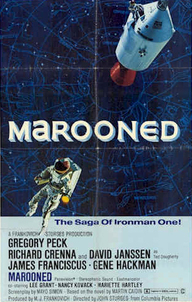 It's been a long road, It's been a long road,getting from there to here. How about a down-to-earth analogy? Here’s my opening for a prequel to Gravity that packs the same plausibility. On a country blacktop road, Clooney furiously pedals a bicycle. A trailing rope pulls a wobbly Bullock on skates. Topping a hill sends Bullock zooming past yelling, “I HATE SKATES!” Clooney encourages her onward, “Well looky there, swarms of killer bees!” he charmingly drawls. “We can beat those ol' bees by jumping onto that flaming race car I see over there in the next state.” Whoa. Back to the movie. Clooney’s character unbuckles the tether. Why? How is this required? Oh, I get it. He is neither sacrificial nor stupid. He just wants to get out of this movie. He has figured out that the screenplay chose a half dozen orbital dramas and stitched them together. I really tried to reattach my tether to Gravity, but these repeated disconnects kept spinning me off. An awesome five-hundred-plus space travelers walk the earth, but those, their support staff, and we astronerds represent relatively few tickets. By contrast, a quarter of Americans think the sun orbits the earth. (Here, page 7-23.) Real space travel is boring. 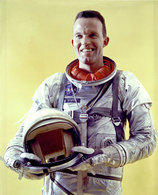 Or is it? Before the real-life survival drama of Apollo 13, there was the real-life survival drama of Faith 7. The one-day solo space flight of Gordon Cooper was about done when power began to fail. Exhaled carbon dioxide and temperature built up. Calmly, Cooper manually aligned the ship to constellations in the window. Given a radioed countdown and his wristwatch, “Gordo” fired rockets, held the Mercury capsule at the needed angle, and from skimming the globe at 17,000 miles per hour punched through to a flawless splashdown four and a half miles from the target. Now there’s a guy with the right stuff. 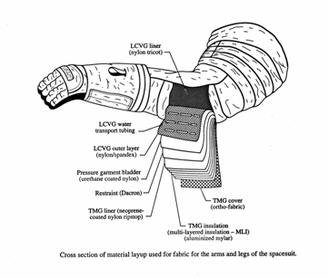 We switch to interior scenes. Of course Miss Congeniality takes off her space suit. I worked with an engineer who helped design space suits. “Layers. Grannies. That’s what makes a good space suit,” he enlightened me. Take your naked body and glue on a Christmas tree net of electrodes to monitor your health and make you itch. Add a catheter, its bag, and a diaper. Eww, but better than the alternative. A serious body stocking goes on next. Without that, in vacuum lovely Bullock would pump up into vintage Schwarzenegger. It also wicks away the sweat you will generate from fighting your spacesuit which also wants to inflate like a balloon animal. Next comes a layer of temperature and humidity regulation tubes and over a dozen other layers hand sewn by NASA granny seamstresses. 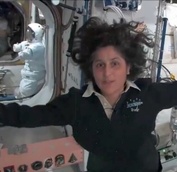 ISS Reality: Sunita Williams ISS Reality: Sunita Williams and weightless hair. People enthuse, “But weren’t the special effects great?” Yes. But as often is the case, reality beats Hollywood. You want videos of the passing earth? They are real and they are gorgeous. Want cavorting weightless astronauts? How about real stars? How does a movie named Gravity show less gravity than any other movie? I miss the truthful titling of 2012, when I could see Lincoln or Abraham Lincoln: Vampire Hunter, and not be disappointed. “Isn't there a human-interest story in Gravity? Isn't there character development? Isn't there courage and ingenuity?” Yes! I’ll leave those to sermons. “Do we need space suits to overcome life's disasters?” Of course not. You meet overcomers every day! Hollywood, I offer you these taglines for new movies:
Spiritual Notes:
0 Comments
Leave a Reply. |
Our Writers:At The Surge we love doing things together... that includes writing a blog! Here are a few of our main contributing authors: Greg JohnsonJesus++ Dwaine DarrahOur fearless leader, Dwaine is the lead pastor at The Surge. His experience in counter terrorism with the CIA prepared him for ministry and he likes dogs and babies even more than E does. EE (short for Eric Reiss) is the Wingman at The Surge and likes dogs, music, Mexican food, his wife Karen and his little girl Evangeline... not necessarily in that order. Archives
June 2024
Categories
All
|
|
|
The Surge Community Church
Meeting Sunday Mornings at The State Theatre in Falls Church, 11:10am! Rebroadcast Available Sunday Evenings with SurgeOnDemand, 7:00pm! |


 RSS Feed
RSS Feed
